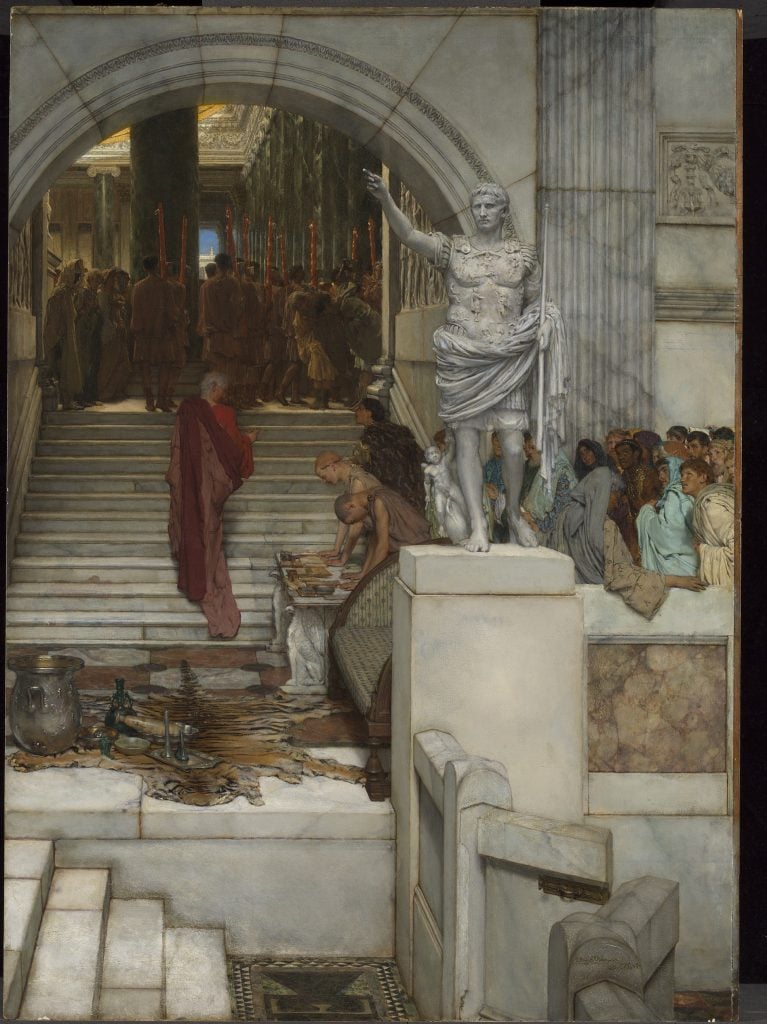Museums & Institutions
London’s National Gallery Acquires Major Victorian Painting for Its 200th Birthday
Sir Lawrence Alma-Tadema was one of the most popular artists of his time.

Sir Lawrence Alma-Tadema was one of the most popular artists of his time.

Vittoria Benzine

The National Gallery in London announced today that after two centuries, they’ve finally acquired a canvas by the critical Dutch-born Victorian painter Sir Lawrence Alma-Tadema. Christie’s brokered the sale of Alma-Tadema’s After the Audience (1879) between the museum and noted Pre-Raphaelite collector Isabel Goldsmith. The National Gallery paid £2 million for the stunning oil painting, which depicts Emperor Augustus’s son-in-law Marcus Vipsanius Agrippa climbing his villa’s staircase after attending to his adoring public. Four individual donors provided funds for the artwork to mark the National Gallery’s 200th anniversary.
“The acquisition represents both Neoclassicism and Aestheticism, two important artistic movements within the Western tradition that have largely been unrepresented at Trafalgar Square,” a release from the National Gallery notes.
Alma-Tadema was born 1836 in the Netherlands. He studied at the Academy of Fine Arts in Antwerp under history painter Gustave Wappers, and went on to assist the artist Louis Jan de Taeye, “who advocated historical accuracy and an appreciation for depicting scenes from the Ancient World,” the National Gallery’s release writes. Alma-Tadema often depicted idealized views of ancient Rome, not only because of this education, but also because he relished fond memories from his Italian honeymoon back in 1863.
The artist relocated to London in 1870 amidst the Franco-Prussian War, and called the city “the only place where, up till then my work had met with buyers.” Alma-Tadema never joined the Pre-Raphaelite Brotherhood, but he did befriend many members, blending their aesthetics with his dramatically lit Dutch perfectionism.
Alma-Tadema painted After the Audience for the British industrialist William Armstrong, who’d salivated over his earlier work Audience with Agrippa (1876) when it was on view at the Royal Academy. To entice Armstrong, Alma-Tadema expanded on his winning formula, this time depicting Agrippa at the end of his civic duties, with resplendent gifts laid out on the platform separating his home from his fans. Both artworks are highly similar, structured around a sculpture based on the Augustus of Prima Porta, which had just been rediscovered in 1863. But, After the Audience trades its predecessor’s bright light and loaded promise for an after-hours glitz akin to a rock concert.
“Armstong seems to have taken such substantial amendments as a personal slight,” the National Gallery;s press officer Neil Evans told Artnet News over email. Although Armstrong never purchased the painting, Alma-Tadema’s peers recognized its beauty when he showed it at the Scottish Royal Academy that year. A release from Christie’s says they sold the work for 90 Guineas in 1947. It’s recently appeared in exhibitions at Amsterdam’s Van Gogh Museum, and London’s Leighton House Museum. An Audience at Agrippa’s, meanwhile, lives at The Dick Institute in Scotland. “It is very satisfying that Before the Audience and After the Audience are now both in public collections, in Kilmarnock and London,” Christie’s senior director Peter Brown has remarked.
After the Audience is the third artwork that the National Gallery has snapped up to celebrate its bicentennial, following their purchase of La Psyché (The Full-length Mirror) (ca. 1869-70) by Eva Gonzalès this spring. After the Audience is now on view in Room 45.